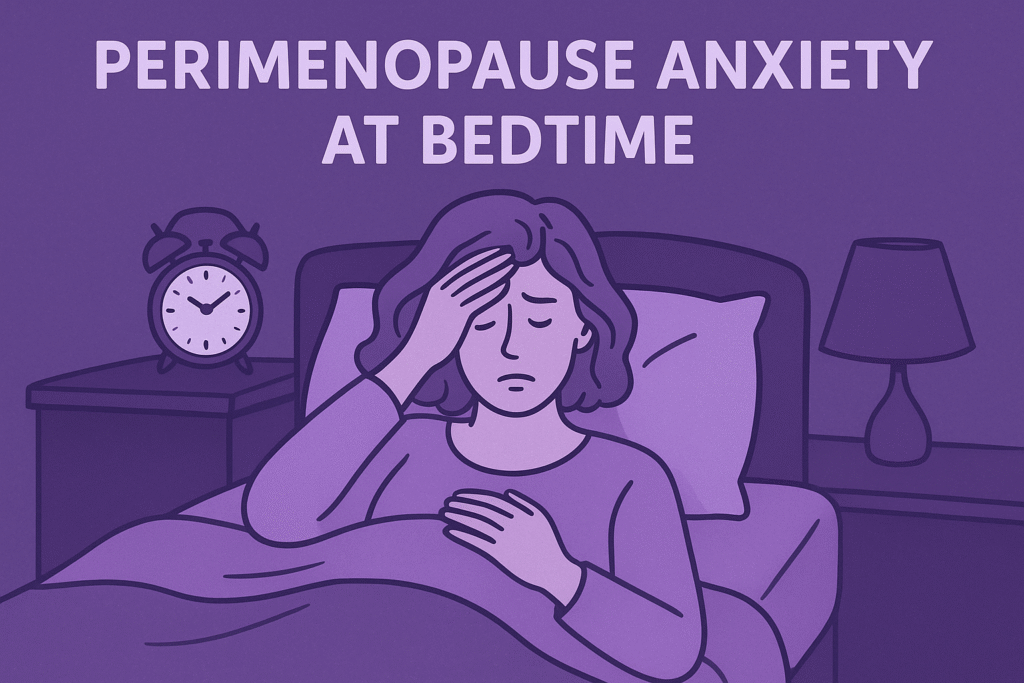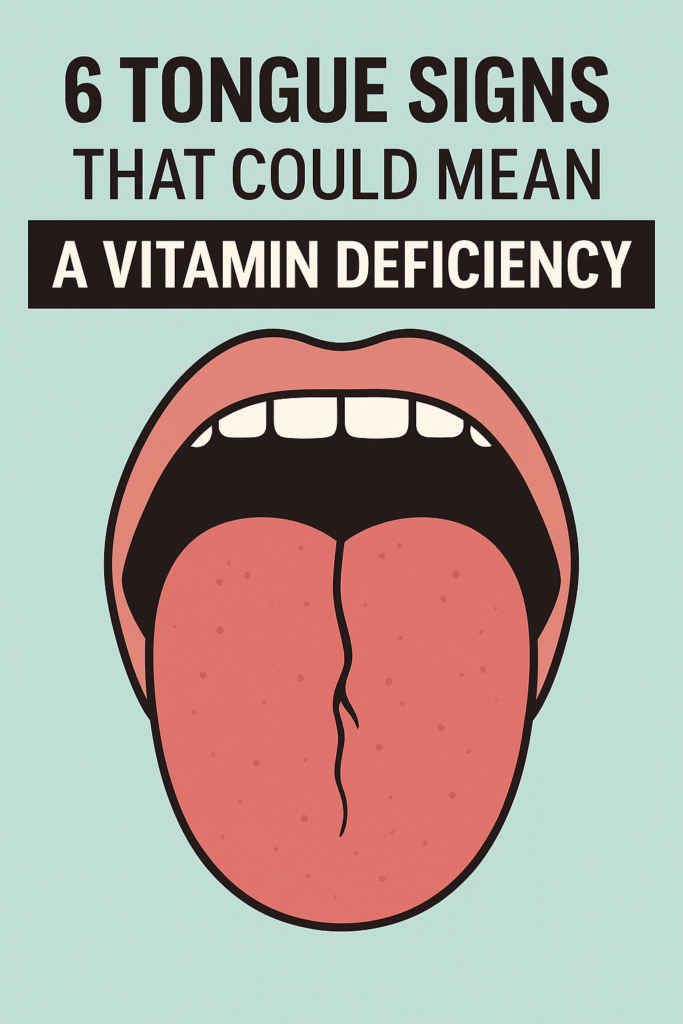
⚠️ Affiliate Disclaimer: This post may contain affiliate links, which means I may earn a small commission — at no extra cost to you — if you make a purchase through one of these links. I only recommend products or services I genuinely trust and believe can provide value. Thank you for supporting My Medical Muse!
Perimenopause Bedtime Anxiety: 9 Proven Ways to Calm Cortisol and Sleep Better
Perimenopause Anxiety at Bedtime: Calming the Cortisol-Sleep Loop
Perimenopause is often described in terms of hot flashes, irregular periods, or shifting hormones, but for many women, its most disruptive symptom appears at night. Bedtime anxiety,the sudden surge of alertness, racing thoughts, or a pounding heart just as you try to sleep can turn what should be a restorative part of the day into a nightly struggle.
This pattern is not a matter of “overthinking” or weak willpower. At its core lies a cortisol–sleep loop. During perimenopause, fluctuating estrogen and progesterone destabilize cortisol, the body’s main stress hormone. Instead of declining smoothly in the evening, cortisol may spike, leaving you restless and keyed-up. Once sleep is delayed or disrupted, cortisol regulation worsens, fueling even more nighttime anxiety. Over time, the bed itself becomes associated with stress, reinforcing the cycle.
The good news is that this loop can be interrupted by understanding the hormonal mechanisms behind bedtime anxiety and applying evidence-based strategies particularly small cognitive behavioral adjustments and calming routines, you can reduce nighttime cortisol surges, retrain the brain to associate bedtime with safety, and rebuild a healthier sleep rhythm.
This article unpacks the biology behind perimenopausal bedtime anxiety, explains why midlife makes women especially vulnerable, and offers practical, science-backed steps to restore calm and confidence at night.
Why Bedtime Anxiety Peaks in Perimenopause
- Perimenopause is a transitional stage, and like most transitions in the body, it creates instability. Sleep already sensitive to stress, light, temperature, and routine becomes particularly vulnerable. The primary culprits are hormonal changes that interfere with the brain’s calming systems, stress regulation, and body temperature control. Together, these shifts explain why anxiety feels sharper and more persistent at night.
Estrogen Decline
Estrogen plays a central role in emotional regulation and sleep quality. It enhances the activity of serotonin and GABA, two neurotransmitters that quiet mental chatter and promote relaxation. As estrogen levels fluctuate and decline during perimenopause, these calming pathways weaken. Without this natural “brake system,” thoughts are more likely to spiral, and bedtime becomes a trigger for overthinking instead of winding down.
Progesterone Decline
Progesterone has a natural sedative effect. It stimulates GABA receptors in the brain, helping you fall asleep more easily and supporting the deeper stages of restorative sleep. When progesterone begins to fall, women often notice fragmented rest, lighter sleep, and a heightened stress response. The result is a nervous system that remains more reactive to small stressors and more susceptible to nighttime cortisol spikes.
Cortisol Dysregulation
In an ideal rhythm, cortisol peaks in the morning to help you wake up and steadily declines toward bedtime, making way for melatonin, the sleep hormone. Perimenopause disrupts this balance. Hormonal fluctuations, poor sleep, and heightened stress sensitivity can lead to evening cortisol surges. Instead of winding down, you feel wired: your heart races, your body feels tense, and your mind fixates on worries. This is the biological core of bedtime anxiety in perimenopause.
Night Sweats and Thermoregulation
Hot flashes and night sweats aren’t just temperature events, they activate the sympathetic nervous system, the body’s fight-or-flight response. When this system switches on, the brain interprets it as a signal of danger, spiking adrenaline and amplifying feelings of unease. That’s why a sudden wave of heat at night often comes with a rush of anxiety, rapid heartbeat, or a sense of impending doom. You’re not just overheated, you’re physiologically primed for alertness at the worst possible moment.
The Cortisol-Sleep Loop Explained
At the center of bedtime anxiety in perimenopause is what can be called the cortisol-sleep loop. Cortisol, the body’s main stress hormone, is meant to follow a predictable daily rhythm: high in the morning to wake you up, gradually tapering throughout the day, and at its lowest at night to allow for restful sleep. In perimenopause, this rhythm often becomes disrupted.
The loop looks like this:
- Hormonal changes in perimenopause: Estrogen and progesterone fluctuations destabilize cortisol regulation, making nighttime surges more likely.
- Cortisol surge at night: Racing thoughts, a pounding heart, and an almost wired feeling make it difficult to fall asleep.
- Poor or fragmented sleep: The next morning, cortisol is already elevated, creating heightened stress sensitivity and setting the stage for another restless night.
- Chronic cycle: Over time, bedtime itself becomes a trigger. The brain learns to associate the bed with stress and hypervigilance, reinforcing insomnia.
Breaking this loop requires a two-pronged approach:
- Physiological reset: lowering nighttime cortisol and calming the nervous system.
- Cognitive reset: retraining the brain to stop linking bedtime with fear, pressure, or performance anxiety.
Signs Your Bedtime Anxiety Is Cortisol-Driven
While many factors can cause nighttime anxiety, cortisol-driven patterns have a few telltale signs. You may recognize yourself if you experience:
- A sudden alertness when lying down, as if your body gets a second wind despite being exhausted.
- Middle-of-the-night wake-ups (2-3 AM), often with a jolt, racing heart, or sense of dread.
- Nighttime-specific worry spikes, even if you feel relatively calm during the day.
- Late-night cravings for sugar, carbs, or caffeine, your body’s way of trying to stabilize blood sugar and cortisol.
- Fragile, restless sleep, with frequent tossing and turning, shallow rest, or feeling unrefreshed in the morning.
If these symptoms sound familiar, it’s a strong sign that your bedtime struggles are not just psychological but hormonally and biologically driven.
Symptom Relief Strategies: Calming the Loop
1. Micro-Routines for Cortisol Regulation
One of the most effective ways to break the cortisol-sleep loop is through short, calming practices that teach the body it is safe to let go at night. These routines don’t require long meditation sessions or complicated rituals, just 5-10 minutes of focused activity that signals to your nervous system: “The day is over. It’s time to rest.”
a. Diaphragmatic Breathing with Extended Exhale
Breathing is one of the fastest ways to shift the nervous system from “fight-or-flight” into “rest-and-digest.” Diaphragmatic breathing, deep belly breathing combined with a deliberately longer exhale calms the body’s stress response.
- How to practice: Place one hand on your abdomen. Inhale slowly through your nose for a count of 4, letting your belly expand. Exhale gently through pursed lips for a count of 6-8, allowing your shoulders to drop. Repeat for 5 minutes.
- Why it works: The extended exhale activates the vagus nerve, which lowers heart rate, reduces cortisol, and signals the brain that it’s safe to relax.
- Pro tip: Pair the breath with grounding, such as silently counting each exhale or gently pressing your hand into your abdomen to anchor attention. This prevents the mind from drifting back into anxious thought loops.
b. Legs Up the Wall Pose (Viparita Karani)
A restorative yoga pose, legs-up-the-wall requires no flexibility and delivers powerful nervous system relief.
- How to practice: Lie on your back with your hips close to a wall, extend your legs upward, and rest them against the wall. Close your eyes, breathe slowly, and stay in the pose for 3-5 minutes.
- Why it works: Elevating the legs improves blood return to the heart, reduces muscle tension, and quiets the sympathetic nervous system. It also lowers heart rate variability, a biomarker of stress recovery.
- Pro tip: Combine this posture with a breathing practice or soft background music to amplify the relaxation response.
c. Warm Compress or Weighted Blanket
Touch and pressure therapies send powerful safety signals to the brain, quieting nighttime cortisol surges.
- Warm compress: Placing a heated eye mask, warm cloth, or hot water bottle across the chest or abdomen stimulates parasympathetic nerves, creating a deep sense of comfort.
- Weighted blanket: Using a blanket that’s about 10% of your body weight provides “deep pressure stimulation.” Research shows it lowers cortisol, boosts serotonin, and increases melatonin production, all of which promote sleep.
- Pro tip: If you run warm at night, choose a cooling weighted blanket to prevent overheating, which can otherwise worsen night sweats.
2. CBT-I Inspired Bedtime Practices
Cognitive Behavioral Therapy for Insomnia (CBT-I) is widely recognized as the most effective long-term treatment for chronic insomnia. For women in perimenopause, its strategies can be adapted into small, targeted practices that address nighttime anxiety without requiring a full therapy program. These micro-tools work by retraining the brain’s associations with bedtime and quieting the cognitive “loops” that keep you awake.
a. Thought Download Ritual
Racing thoughts at night are often your brain’s attempt to “problem-solve” when it should be winding down. A thought download ritual helps shift those mental tasks out of your head and onto paper.
- How to practice: Before getting into bed, write down any lingering worries, to-dos, or intrusive thoughts. Then, close the notebook and tell yourself: “These belong to tomorrow.”
- Why it works: This simple act reassures the brain that important tasks are not being forgotten, reducing the urge to mentally rehearse them in bed.
- Pro tip: Keep a small notebook by your bedside to repeat this ritual consistently. Over time, your brain learns that night is not the time for planning.
b. Worry Scheduling
Anxious minds often look for “processing time,” and bedtime becomes the default. Worry scheduling gives that process a dedicated slot earlier in the evening.
- How to practice: Choose a 15-20 minute window ideally a few hours before bed, where you sit down and allow yourself to worry, journal, or brainstorm solutions.
- Why it works: This trains the brain to associate worry with a specific time and place, making it easier to set it aside when bedtime arrives.
- Pro tip: Pair worry time with a symbolic “closure cue,” like shutting the notebook or turning off a light, to signal to your brain that the task is complete.
c. Stimulus Control
When you stay in bed awake and anxious, your brain starts to associate the bed with frustration instead of rest. Stimulus control interrupts that pattern.
- How to practice: If you’ve been awake for more than 20 minutes, get out of bed and do something quiet and calming in dim light like reading a paper book or listening to soft music. Return to bed only when sleepy.
- Why it works: This resets the brain’s learned association, reinforcing the bed as a place for sleep, not stress.
- Pro tip: Keep a low-light “night station” ready in another room, a chair, blanket, and calming activity so you don’t wander aimlessly when you get up.
3. Nutrition for Nighttime Calm
What you eat (and avoid) in the hours before bed can have a direct impact on cortisol levels, neurotransmitter balance, and sleep quality. Small nutritional adjustments can make the difference between lying awake and drifting off smoothly.
- Magnesium Glycinate or Citrate
- Magnesium supports GABA activity, the brain’s main calming neurotransmitter. It also helps regulate cortisol and reduce muscle tension.
- Tip: Magnesium glycinate is gentler on digestion, while citrate may also support bowel regularity if constipation is an issue.
- Magnesium supports GABA activity, the brain’s main calming neurotransmitter. It also helps regulate cortisol and reduce muscle tension.
- Tart Cherry Juice
- Tart cherries are a natural source of melatonin, the hormone that signals your body it’s time to sleep. Studies show small nightly doses can modestly improve sleep duration and quality.
- Tip: Choose unsweetened tart cherry juice to avoid late-night sugar spikes.
- Complex Carbohydrate Snack
- A small snack with complex carbs (such as oatmeal, a banana, or a rice cake) helps stabilize blood sugar and supports serotonin production, which in turn supports melatonin.
- A small snack with complex carbs (such as oatmeal, a banana, or a rice cake) helps stabilize blood sugar and supports serotonin production, which in turn supports melatonin.
Keep portions light, too much food before bed can cause indigestion and disrupt sleep.
- Avoid Alcohol
- Although alcohol may make you feel drowsy initially, it fragments sleep, suppresses REM cycles, and triggers a cortisol rebound in the early morning hours.
- Tip: If you enjoy a glass of wine, try to have it with dinner rather than close to bedtime, or consider alcohol-free alternatives during the week.
- Although alcohol may make you feel drowsy initially, it fragments sleep, suppresses REM cycles, and triggers a cortisol rebound in the early morning hours.
4. Environment Tweaks That Matter
- Cool temperature (65-68°F / 18-20°C): Helps with hot flashes and nervous system calm.
- Red or amber night light: Prevents melatonin suppression.
- No digital devices in bed: Blue light and notifications amplify cortisol.
5. Hormonal & Medical Support
For women whose anxiety and insomnia remain severe:
- Low-dose hormonal therapy (HT): Can stabilize estrogen/progesterone balance.
- SSRIs or SNRIs: Sometimes prescribed for perimenopausal anxiety.
- Herbal supports: Ashwagandha, valerian, or black cohosh may help (though results vary).
- Professional CBT-I therapy: Offers structured coaching beyond self-applied micro-tools.
Building a Nightly Ritual: Sample Routine
Here’s a 15-minute wind-down plan that combines the most effective micro-interventions:
- 10 min before bed: Write down worries + tomorrow’s to-dos.
- 5 min breathing practice: Inhale 4, exhale 6-8, while lying with legs up the wall.
- Bedroom setup: Cool room, weighted blanket ready, lights dimmed.
- If waking at 2-3 AM: Place a hand on your chest, extend exhale, remind yourself: “This is cortisol, not danger.”
Long-Term Reset: Breaking the Loop
Breaking the cortisol-sleep loop in perimenopause isn’t just about nightly rituals, it’s about retraining your body and brain over time. Long-term strategies focus on restoring confidence in sleep, stabilizing hormonal rhythms, and building supportive systems that reinforce restful nights.
Step 1: Rebuild Sleep Confidence
Chronic insomnia often feeds on the fear of not sleeping. Ironically, this anxiety can make falling asleep even harder. The first step in resetting the loop is to remind yourself that sleep is a biological drive, it will come naturally when the body is ready.
- How to practice:
- Reframe bedtime thoughts: replace “I’ll never sleep tonight” with “Rest will come in its own time.”
- Track positive sleep moments in a journal, short periods of deep sleep, quick sleep onset, or fewer night awakenings. This builds confidence that your body can sleep, even if not perfectly.
- Reframe bedtime thoughts: replace “I’ll never sleep tonight” with “Rest will come in its own time.”
- Why it works: Confidence reduces anticipatory anxiety and lowers nighttime cortisol, making sleep easier over time.
Step 2: Anchor Cortisol with Morning Routines
Cortisol and melatonin follow a natural daily rhythm. Strengthening that rhythm helps the body know when to wake and when to wind down.
- Morning light exposure: Spending 10-15 minutes in natural sunlight within an hour of waking resets the circadian clock, signaling to the brain that the day has begun.
- Consistent wake time: Even on weekends, waking at the same time reinforces the cortisol-melatonin cycle, making it easier to fall asleep at night.
- Additional anchors: Gentle morning movement, hydration, and breakfast with protein and complex carbs can further stabilize morning cortisol and set the tone for the day.
Step 3: Layer Support Systems
Sleep is not just physiological it’s also psychological and social. Building external support reinforces your internal efforts.
- Partner /family awareness: Let those you live with know what’s happening. Simple changes like minimizing late-night noise or helping with chores can reduce nighttime stress.
- Progress journaling: Record improvements such as fewer night awakenings, shorter time to fall asleep, or calmer bedtime thoughts. Visual evidence of progress reinforces confidence and motivation.
- Professional support: If anxiety or insomnia remains persistent or disabling, consult a healthcare professional. Options include hormone therapy, sleep-focused therapy, or targeted medications. Early intervention can prevent chronic sleep disruption and protect overall health.
By combining these steps, confidence-building, circadian anchoring, and support networks. You create a long-term framework that weakens the cortisol–sleep loop, allowing calmer, more restorative nights to become the new normal.
Final Thoughts
Perimenopause bedtime anxiety is not “just stress.” It is the visible symptom of a deeper cortisol-sleep loop, amplified by hormonal shifts and changes in the nervous system. Understanding this loop is the first step toward reclaiming calm nights.
The strategies outlined in this article, micro-routines, CBT-I-inspired practices, nutrition adjustments, environment tweaks, and long-term rhythm resets, work together to retrain both body and mind. They help your nervous system learn that bedtime is safe, your brain that worries can wait, and your hormones that rest is normal and restorative.
It’s important to remember that the goal is not perfect sleep. Instead, it is predictable calm at bedtime, night after night. Each time you practice these routines, you weaken the cortisol-sleep loop and reinforce the natural rhythms your body was designed to follow. Over weeks and months, these small, consistent changes accumulate, producing more restful, restorative sleep, even in the midst of perimenopause.
With the right tools and persistence, sleep can stop feeling like a nightly battle and start feeling like what it should be: a reliable reset for your body, mind, and hormones. Nighttime anxiety may not vanish instantly, but with patience and practice, it can be managed, reduced, and eventually replaced with calm and confidence at bedtime.
👩⚕️ Need Personalized Health Advice?
Get expert guidance tailored to your unique health concerns through MuseCare Consult. Our licensed doctors are here to help you understand your symptoms, medications, and lab results—confidentially and affordably.
👉 Book a MuseCare Consult NowRelated Blog Post You Might Like:
- Why Do I Wake Up at 3 AM During Perimenopause? 9 Proven Fixes That Work
- Insomnia in Perimenopause and Menopause: 7 Proven Fixes for Restful Sleep
- Postpartum Insomnia: 7 Powerful Reasons New Mothers Struggle to Sleep
- Night Sweats Before Period or Perimenopause? 7 Clear Ways to Tell and Sleep Better
- 12 Early Warning Signs of Thyroid Issues in Women Over 35 You Need to Know


